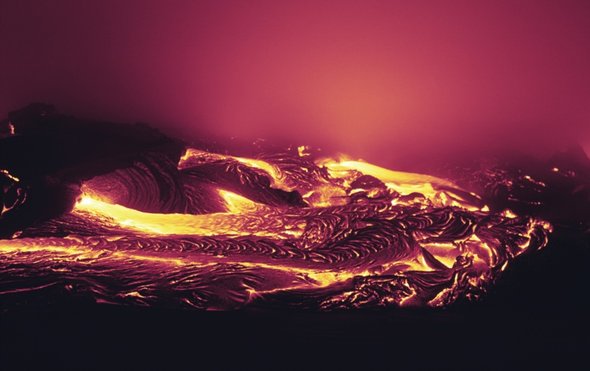(单词翻译:单击)
听力文本
Hi, I'm Scientific American podcast editor Steve Mirsky. And here's a short piece from the April issue of the magazine, in the section we call Advances: Dispatches from the Frontiers of Science, Technology and Medicine:
Hot Rocks by Shannon Hall
For the past 200 million years New England has been a place without intense geologic change. With few exceptions, there have been no rumbling volcanoes or major earthquakes. But it might be on the verge of awakening.
Findings published this January in the journal Geology show a bubble of hot rock rising underneath the northern Appalachian Mountains. The feature was first detected in 2016 by EarthScope, a collection of thousands of seismic instruments sprinkled throughout the U.S. Vadim Levin, a geophysicist at Rutgers University, says this wealth of sensors lets earth scientists peer under the North American continent, just as the Hubble Space Telescope has enabled astronomers to gaze deep into the night sky. Should the broiling rock breach the surface—which could happen, though not until tens of millions of years from now—it would transform New England into a burbling volcanic landscape.

The finding has sparked many questions, given that New England is not located along an active plate margin (where one tectonic plate rubs against another) but sits squarely in the middle of the North American plate. The exact source of the hot rock bubble, for example, is unclear. Because the edge of the North American continent is colder than a plate near an active margin, Levin suspects this edge is cooling the mantle—the layer just below the crust that extends toward the earth's core. As cold chunks of mantle sink, they may displace hotter segments, which would rise toward the surface. Scientists believe they have now imaged such an ascending piece. Although it sounds simple, this scenario is — according to Levin — "a story that at present does not have a place in a textbook."
Or perhaps pieces of the North American continent are breaking off and sinking into the mantle (which would also push the warmer mantle upward), observes William Menke, a geophysicist at Columbia University, who was not part of the study.
Scientists do not yet know which model is correct or if an entirely different one may be involved. Levin and his colleagues are eager to collect more data to bring this unusual hotspot into sharper focus and, in doing so, flesh out the theory of plate tectonics. He says, "we know little about the interior of our planet, and every time we look with a new light... we find things we did not expect. When we do, we need to rethink our understanding of how the planet functions."
That was Hot Rocks by Shannon Hall.
参考译文
大家好,我是《科学美国人》播客的编辑史蒂夫·米尔斯基。以下是本杂志4月份刊登的一篇短文,收录在“进展:科学、科技和医学前沿快报”分类中。
《岩浆》,作者:香农·霍尔
过去2亿年来,新英格兰地区一直未发生过剧烈的地质变化。除了极少数的例外,这里没有轰鸣的火山也没有发生过大型地震。但是该地区可能即将苏醒。
今年1月发表在《地质学》期刊上的研究发现,阿巴拉契亚山脉北部地下岩浆中的气泡正在上升。这一特征在2016年由“地球透镜”计划首次检测到,该计划在美国各地覆盖了数千台地震探测仪器。美国罗格斯大学的地质学家瓦迪姆·莱文表示,这样大量的感应器使地球科学家得以观察北美大陆的地下样貌,就像哈勃太空望远镜让天文学家可以深入凝视夜空一样。如果炽热的岩浆将来冲破地表——这可能会发生,尽管是在数千万年之后——那新英格兰地区会变成汩汩冒泡的火山景观。
这项研究引发了许多问题,因为新英格兰并不处于活动板块边缘(即构造板块相互摩擦之处),而是坐落在北美板块正中央。比如,岩浆气泡的确切来源尚不清楚。因为北美大陆边缘的温度比活动边缘附近的板块要冷,莱文怀疑该边缘地带降低了地幔的温度,地幔是地壳下面延伸至地心的区域。随着寒冷的厚重地幔不断下沉,其可能会取代较热部分的位置,而较热的部分则会上升至地表。科学家认为他们现在已经想象出了上升的部分。尽管这听起来很简单,但是莱文认为,这种设想“目前还未出现在教科书中”。
亦或是北美大陆有些部分正在断裂并陷入地幔中(这也会将较温暖的地幔向上推),这是哥伦比亚大学的地球物理学家威廉姆斯·门克的观点,他没有参与研究。
目前科学家尚不清楚哪种模型是正确的,或者是否涉及完全不同的模型。莱文和同事正在积极地收集更多数据,目的是使这一不同寻常的热点成为焦点,并在此过程中充实板块构造理论。莱文说,“我们对地球内部知之甚少,每次我们用新视角去观察,都会发现我们未曾料到的事情。每当这时,我们就需要重新思考我们对地球运行方式的理解。”
以上是香农·霍尔发表的文章《岩浆》。
译文为可可英语翻译,未经授权请勿转载!
重点讲解
重点讲解:
1. on the verge of 即将;接近于;濒于;
There's no one she can talk to, and she's on the verge of collapse.
她找不到一个可以倾诉的对象,快要崩溃了。
2. in the middle of 中部;中央;中间;
I reached for the lamp, which stood in the middle of the table.
我伸手去够位于桌子中央的灯。
3. break off 折断;(使)断开;
The two wings of the aircraft broke off on impact.
飞机的两个机翼遭受撞击折断了。
4. flesh out 加细节于;使丰满;充实;
In general, it is not that hard to flesh out such details.
通常,充实这类细节内容并不是很难。


